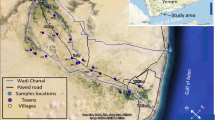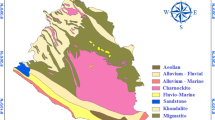Abstract
This study aims to investigate the occurrence of natural radiation in groundwater with an elevated background level in Juban District, Yemen, and to assess the corresponding health risk. The mean concentrations of U, Th, and K in groundwater were 11.25, 0.15, and 17.35 mg l−1, respectively. The mean activity concentrations of 226Ra, 228Ra, and 40K were 94, 216, and 3306 mBq l−1, respectively. 65 % of the groundwater samples were above the WHO guidance level for 228Ra in water. The maximum concentrations of 226Ra, Th, and 228Ra were found around the fault zones in the basement aquifer while the concentrations of U increase down-gradient of Juan District. The principal factors controlling the occurrence and concentrations of radionuclides are aquifer type, leaching behaviour, characteristics of fracture systems, salinity, and water flow path. The annual effective doses due to ingestion of the water were estimated for infant and adult groups. The mean annual effective dose for infants was 1.97 mSv year−1 which is almost twenty times the WHO guideline level for drinking water. The ingestion dose deduced for adults and infants is dominated by 228Ra, where the average contribution from 228Ra in infants amounted to 90 % and in adults 76 %.





Similar content being viewed by others
References
Abd Rahman S, Hamzah MS, Sanuri E, Baharuddin A (2007) Trace element analysis of samples by inductively coupled plasma mass spectrometry (ICP-MS). Nuclear Malaysia Technical Convention at Malaysian Nuclear Agency, Bangi
Abdurabu WA, Ramli AT, Saleh MA, Heryansyah A, Alnhary A, Fadhl S (2016a) Terrestrial gamma dose rate, radioactivity and radiological hazards in the rocks of an elevated radiation background in Juban District, Ad Dali’ Governorate, Yemen. J Radiol Prot 36:163–177
Abdurabu WA, Ramli AT, Saleh MA, Heryansyah A (2016b) The activity concentrations of 222Rn and corresponding health risk in groundwater samples from basement and sandstone aquifer; the correlation to physicochemical parameters. Radiat Phys Chem 127:34–41
Ajayi OS, Owolabi TP (2008) Determination of natural radioactivity in drinking water in private dug well in Akure, southwestern Nigeria. Radiat Prot Dosim 128(4):477–484
Altıkulac A, Turhan S, Gumus H (2015) The natural and artificial radionuclides in drinking water samples and consequent population doses. J Radiat Res Appl Sci. doi:10.1016/j.jrras.2015.06.007
Beyermann M, Bunger T, Schmidt K, Obrikat D (2010) Occurrence of natural radioactivity in public water supples in Germany: 238U, 234U, 235U, 228Ra, 226Ra, 222Rn, 210Pb, 210Po and gross alpha activity concentration. Radiat Prot Dosim 141(1):72–81
Calin MR, Ion AC, Radu I (2015) Evaluation of quality parameters and of natural radionuclides concentrations in natural mineral water in Romania. J Radioanal Nucl Chem 303:305–313
Chau ND, Dulinski M, Jodlowski P, Nowak J, Rozanski K, Sleziak M, Wachniew P (2011) Natural radioactivity in groundwater—a review. Isot Environ Health Stud 47(4):415–437
Desideri D, Roselli C, Feduzi L, Meli MA (2007) Radiological characterization of drinking waters in Central Italy. Microchem J 87:13–19
El-Mageed AI, El-Kamel AH, Abbady A, Harb S, Youssef AMM, Saleh II (2011) Assessment of natural and anthropogenic radioactivity levels in rocks and soils in the environments of Juban town in Yemen. Radiat Phys Chem 80(6):710–771
El-Mageed AI, El-Kamel A, Abbady A, Harb S, Saleh II (2013) Natural radioactivity of ground and hot spring water in some areas in Yemen. Desalination 321:28–31
International Atomic Energy Agency IAEA (1989) Measurement of radiation in food and the environment. Guidebook. Technical report series no. 295, IAEA,Vienna
International Commission on Radiological Protection ICRP (1996) Age-dependent doses to members of the public from intake of radionuclides: Part 5 Compilation of ingestion and inhalation dose coefficients. ICRP Publication 72
International Commission on Radiological Protection ICRP (2012) Compendium of dose coefficients based on ICRP Publication 60. ICRP Publication 119. Ann. ICRP 41(Suppl)
Isam SMM, Pettersson HBL, Lund E (2002) Uranium and thorium series radionuclides in drinking water from drilled bedrock wells: correlation to geology and bedrock radioactivity, and dose estimation. Radiat Prot Dosim 102(3):249–258
Jain CK, Kumar CP, Sharma MK (2003) Ground water qualities of Ghataprabha command area Karnataka. Indian J Environ Ecoplan 7(2):251–262
Kraemer TF (1991) Uranium, radium, and radon in deeply buried sediments of the U.S. Gulf Coast. In: Gundersen LCS, Wanty RB (eds) In Field studies of radon in rocks, soils, and water. U.S. Geological Survey Bulletin, pp 313–317
Kraemer TF, Genereux DP (1998) Isotope tracers in catchment hydrology. In: McDonnell CKJ (eds) Applications of uranium- and thorium-series radionuclides in catchment hydrology studies, Amsterdam, pp 679–722
Kumar A, Tripathi RM, Rout S, Mishra MK, Ravi PM, Ghosh AK (2014) Characterization of groundwater composition in Punjab state with special emphasis on uranium content, speciation and mobility. Radiochim Acta 102(3):239–254
Kumar A, Karpe RK, Rout S, Gautam YP, Mishra MK, Ravi PM, Tripathi RM (2016) Activity ratios of 234U/238U and 226Ra/228Ra for transport mechanisms of elevated uranium in alluvial aquifers of groundwater in southwestern (SW) Punjab, India. J Environ Radioact 151:311–320
Langmuir D, Riese AC (1985) The thermodynamic properties of radium. Geochim Cosmochim Acta 49:1593–1601
Michel J (1990) Relationship of radium and radon with geological formations. In: Cothern CR, Rebers PA (eds) Radon, radium and uranium in drinking water. LEWIS, INC, Michigan
Natural Resources Project NRP (1990) Fixed-wing low level magnetic and radiometric surveys, Yemen, vol 1. Geological Survey and Mineral Resources Board, Yemen, Sana’a, pp 245–260
Osman AA, Isam SMM, Ibrahim A, Saif S, Siddeeg MB, Eltayeb H, Idriss H, Hamza W, Yousif EH (2008) Investigation of natural radioactivity levels in water around Kadugli, Sudan. Appl Radiat Isot 66(11):1650–1653
Porcelli D (2008) Investigating groundwater processes using U- and Th-series nuclides. In: Krishnaswami S, Cochran JK (eds) Radioactivity in the environment: U–Th series nuclides in aquatic systems, vol 13, 1st edn. Elsevier, Amsterdam, pp 105–153
Ramadan KA, Seddeek MK, Nijim A, Sharshar T, Badran HM (2011) Radioactivity of sand, groundwater and wild plants in northeast Sinai, Egypt. Isot Environ Health Stud 47(4):456–469
Ranil A, Duggal V, Balaram V (2013) Uranium estimation in drinking water samples from some areas of Punjab and Himachal Pradesh, India using ICP-MS. Radiat Prot Dosim 157(1):146–151
Saleh MA, Ramli AT, Alajerami Y, Aliyu AS, Bt Basri NA (2013a) Radiological study of Mersing District, Johor, Malaysia. Radiat Phys Chem 85:107–117
Saleh MA, Ramli AT, Alajerami Y, Aliyu AS (2013b) Assessment of environmental 226Ra, 232Th and 40K concentrations in the region of elevated radiation background in Segamat District, Johor, Malaysia. J Environ Radioact 124:130–140
Saleh MA, Ramli AT, Hamzah K, AlajeramiY MM, Aliyu AS, Gabdo HT, Garba NN (2014) Assessment of radiological health implications from ambient environment in the Muar District, Johor, Malaysia. Radiat Phys Chem 103:243–252
Saleh EE, El-Mageed AI, El-Gamal H, Hussien MT (2015) Assessment of radiation hazards a result of natural radioactivity in water from Abyan delta, Yemen. J Radioanal Nucl Chem 304:1235–1241
Salonen L (1994) A 238U series radionuclides as a source of increased radioactivity in groundwater originating from Finnish bedrock In: Soveri J, Suokko T (eds) IAHS Publication, IAHS Press, Oxfordshire, pp 71–84
Senior LA, Vogel KL (1995) Radium and radon in ground water in the chickies quartzite, Southeastern Pennsylvania. U.S. Geological Survey water-resources investigations report 92-4088, Lemoyne, Pennsylvania
Shabana EI, Kinsara AA (2014) Radioactivity in the groundwater of a high background radiation area. J Environ Radioact 137:181–189
USEPA (2007) Drinking water standards and health advisories table. http://www3.epa.gov/region9/water/drinking/files/dwsha_0607.pdf. Accessed 16 Dec 2015
Wanty RB, Schoen R (1991) A review of the chemical processes affecting the mobility of radionuclides in natural waters, with applications In: Gundersen LCS, Wanty RB (eds) In field studies of radon in rocks, soils, and water, U.S. Geological Survey Bulletin, 183–192
Wo YM, Ahamd Z (2008) Validation of Ra-226 and K-40 measurement in environmental samples using gamma spectrometry. Malays J Anal Sci 12(1):179–186
World Health Organization WHO (2008) Guidelines for drinking-water quality [electronic resource]: incorporating 1st and 2nd addenda, recommendations, vol 1. World Health Organization, 197–209. http://www.who.int/water_sanitation_health/dwq/fulltext.pdf. Accessed 18 Jan 2015
Acknowledgments
The authors would like to thank Ministry of Higher Education Malaysia for financial support. This study is supported by Universiti Teknologi Malaysia (UTM) through Research University Grant scheme project number Vot no Q.J 30000.2642.10J86. The field work was supported and funded through collaboration with American Institute for Yemeni Studies (AIYS). The authors are thankful to the staff of Nuclear Laboratory at Universiti Teknologi Malaysia (En. Saiful Bin Rashid). The authors are thankful to the staff of the Analytical Chemistry Laboratory at Malaysian Nuclear Agency (Shamsiah A. Rahman, Ms Ezwiza Sanuri, and Mr Abdul Halim Baharuddinin). The authors would also like to thank Mr. Ali Alsuremi, President of National Water Resources Authority, for his great assistance. The authors also acknowledge, with thanks, technical support of the National Atomic Energy Commission and Yemeni Geological Survey and Mineral Resources Board (GSMRB), Yemen.
Author information
Authors and Affiliations
Corresponding author
Rights and permissions
About this article
Cite this article
Abdurabu, W.A., Saleh, M.A., Ramli, A.T. et al. Occurrence of natural radioactivity and corresponding health risk in groundwater with an elevated radiation background in Juban District, Yemen. Environ Earth Sci 75, 1360 (2016). https://doi.org/10.1007/s12665-016-6142-z
Received:
Accepted:
Published:
DOI: https://doi.org/10.1007/s12665-016-6142-z




